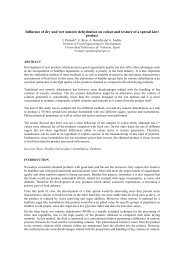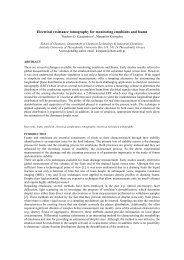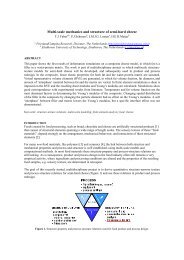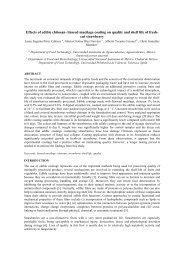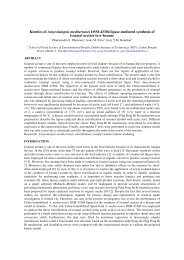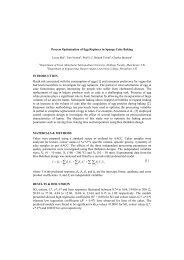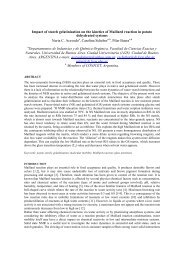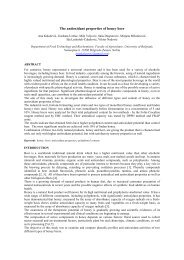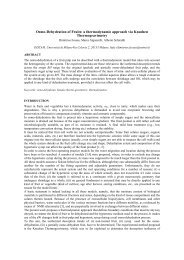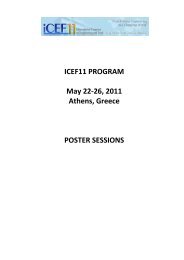Functional properties of foods. Database and model prediction
Functional properties of foods. Database and model prediction
Functional properties of foods. Database and model prediction
You also want an ePaper? Increase the reach of your titles
YUMPU automatically turns print PDFs into web optimized ePapers that Google loves.
content, feed rate, screw speed, screw configuration. Other affecting factors may include raw material<br />
formulation, pre-processing treatments, initial particle size <strong>of</strong> milled materials, <strong>and</strong> the milling procedure. A<br />
preliminary statistical investigation shows that we have a strong relationship between WAI or WSI <strong>and</strong> 4<br />
independent variables such as die temperature, feed moisture content <strong>of</strong> food product in wet base %, screw<br />
speed <strong>of</strong> extruder <strong>and</strong> blend level% mainly for starchy <strong>and</strong> proteinaceous extruded food products. It is found<br />
from the <strong>model</strong>ling exercise that using a <strong>model</strong>, which considers power law dependency <strong>of</strong> all independent<br />
variables, provides the best performance in the <strong>model</strong>:<br />
WAI or WSI<br />
<br />
a <br />
<br />
T<br />
T o<br />
where WAI: water absorption index (dimensionless), WSI: water solubility index (%), T: die temperature <strong>of</strong><br />
extruder ( o C), X: feed moisture content <strong>of</strong> food product in wet base %, S: screw speed <strong>of</strong> extruder (rpm), M:<br />
mixture <strong>of</strong> blend %, variables with subscripts: reference steady average values <strong>of</strong> independent variables,<br />
a,b,c,d,e: dimensionless adjustment parameters.<br />
Similarly, concerning the property <strong>of</strong> PDI the intended <strong>model</strong> is:<br />
b<br />
PDI a <br />
T <br />
<br />
<br />
T <br />
o <br />
t<br />
t<br />
where PDI: protein dispersibility index (%), T: is the temperature <strong>of</strong> the product which was exposed during<br />
preparation ( o C), t: is the corresponding residence time (10 3 *s), variables with subscripts: reference steady<br />
average values <strong>of</strong> independent variables, a,b,c: dimensionless adjustment parameters.<br />
The parameter estimation was performed by the Levenberg–Marquardt (LM) algorithm. The LM algorithm is<br />
an iterative technique that locates the minimum <strong>of</strong> a multivariate function that is expressed as the sum <strong>of</strong><br />
squares <strong>of</strong> nonlinear real-valued functions. The s<strong>of</strong>tware package Stargraphics Centurion v. XV (Manugistics<br />
Inc. Rockville, MD, USA) was used for the nonlinear regression analysis.<br />
RESULTS & DISCUSSION<br />
b c<br />
X <br />
<br />
<br />
X<br />
<br />
o <br />
c<br />
<br />
<br />
o <br />
Table 1 presents, in a compact form, the main information concerning the examinee <strong>properties</strong>. The<br />
minimum, maximum, average values <strong>and</strong> the st<strong>and</strong>ard deviation for each <strong>of</strong> six <strong>properties</strong> are presented in the<br />
first four columns. The main food systems <strong>and</strong> the factors which altered the value <strong>of</strong> <strong>properties</strong> are presented<br />
in the fifth <strong>and</strong> sixth columns respectively. Finally, the total number <strong>of</strong> experimental data which was<br />
retrieved is presented in the final column.<br />
Table 1. Data compiled from literature about examinee functional <strong>properties</strong> used in statistical analysis<br />
Property MIN MAX AVG SD a Food System Main Factor N b<br />
WAI 0.3 14.4 4.8 1.9 Corn, Wheat,<br />
Rice Flours<br />
WSI 0.2 94.8 22.4 15.4 Corn, Wheat,<br />
Rice Flours<br />
PDI 1.3 100.0 42.0 42.0 Soybean<br />
Products<br />
NSI 2.5 94.0 40.7 19.4 Soybean<br />
Products<br />
Extrusion parameters,<br />
blends<br />
Extrusion parameters,<br />
blends<br />
pH, Heat, Enzymatic<br />
Hydrolysis<br />
pH, Heat, Enzymatic<br />
Hydrolysis<br />
GI 1.0 100.0 71.0 25.1 Wheat Products Genotype, Fertilization,<br />
Location, Subunits<br />
WG 0.2 60.9 29.6 9.2 Wheat Products Genotype, Fertilization,<br />
Location, Subunits<br />
a St<strong>and</strong>ard Deviation; b Number <strong>of</strong> retrieved data<br />
S<br />
S o<br />
d e<br />
M<br />
<br />
<br />
M<br />
<br />
o <br />
Due to the large number <strong>of</strong> replicates, a fundamental prerequisite for the least squares fitting <strong>of</strong> the <strong>model</strong>s to<br />
the corresponding data sets is equal variance <strong>of</strong> the different observations. The results <strong>of</strong> these tests show that<br />
the variance was almost steady. The results <strong>of</strong> the nonlinear regression analysis <strong>of</strong> fitting the equation 1 to the<br />
experimental points are shown in Table 2. In this table the st<strong>and</strong>ard experimental error <strong>and</strong> the st<strong>and</strong>ard<br />
deviation between experimental <strong>and</strong> calculated values are also presented. In most cases the values <strong>of</strong> the<br />
1268<br />
1083<br />
1067<br />
780<br />
3400<br />
2354<br />
(1)<br />
(2)



